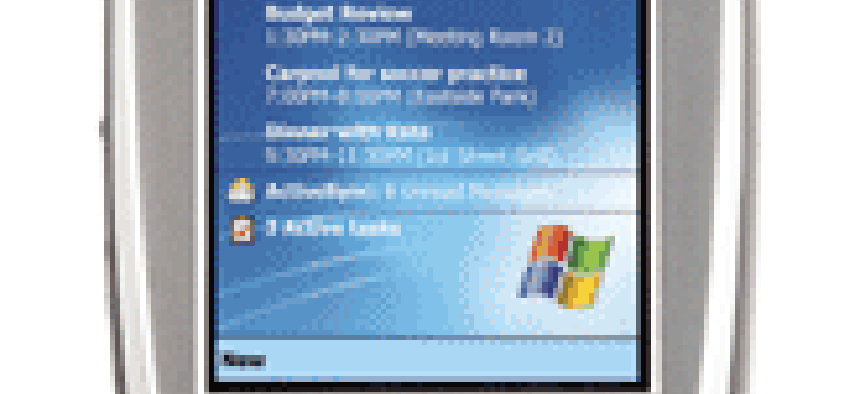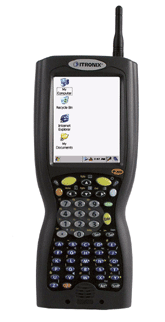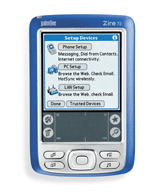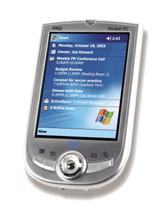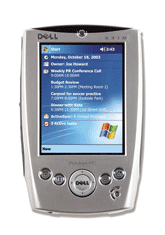Handheld computing is in a state of flux, as the makers of some personal digital assistants add features while others branch into combos that include phones, cameras and other goodies.The market for PDAs in the United States, in fact, might have reached a saturation point, said David Linsalata, an associate analyst with researcher International Data Corp. of Framingham, Mass.[IMGCAP(2)] 'We see a slight decline in the U.S. market, going forward,' Linsalata said. 'This is coming for a number of reasons. One is competition from convergence devices,' such as Research In Motion Ltd.'s BlackBerry pager/personal information manager/e-mail handheld and smart phones that run the Microsoft Windows Mobile operating system.The pure handheld manufacturing community is shrinking somewhat. Last year, PalmOne, the hardware spinoff of the old Palm Inc., acquired Handspring Inc., consolidating 11 devices from the two companies down to six.Sharp Electronics' Zaurus line of Linux-based PDAs contracted from two to one, and NEC Solutions America remains distant from a PDA market it once embraced, offering only a handheld computer running Microsoft Windows CE.Net operating system, a cousin of the phone-and-PDA-friendly Windows Mobile 2003.What's more, it's been nearly two years since any new major players have joined the PDA bandwagon: Dell introduced its Axim line in 2002. While hardware manufacturers such as Dell, Toshiba America Information Systems and Hewlett-Packard have launched several new models of handhelds, users will have to wait for a new 'reference design,' observers said.Instead, makers such as Toshiba, Dell, HP and Sony are packing more features and flexibility into their handhelds, while in some cases maintaining or lowering hardware prices.But when the next major hardware design for Microsoft systems does arrive, it could well be in a convergence device that frees the mobile worker from having to tote both a phone and a PDA.PalmOne's Treo 600, inherited from Handspring, and Motorola's MPx200 each can fulfill that charter to one degree or another. Later this year, Motorola Inc. is expected to launch another phone/PDA combo that will feature a screen capable of portrait- and landscape-mode displays, said Ed Suwanjindar, lead product manager in Microsoft's mobile and embedded devices unit.Taking a page from devices such as PalmOne's Tungsten T3, and several Linux handhelds, Microsoft in March announced a revision to its Windows Mobile 2003 operating system that allows for dual screen orientations.'The main thing that just came out is support for new screen orientations and resolutions,' Suwanjindar said in a telephone interview. 'This will allow dynamic switching between portrait and landscape mode. Additionally there is support for square screen resolution, for devices with keyboards, and new [screen] resolutions for higher dot pitch and LCD displays.'[IMGCAP(3)] Suwanjindar said an enhanced Web browser will be included in the software update. It will have a feature called one-column that he said will cut down on a user's need to horizontally scroll Web pages. It 'takes the width of [a Web] page and cuts along natural breaks,' he said.The new VGA display support, he added, should help government users 'who want to run high-intensity applications in terms of user interface, and have a richer experience graphically. The new screen resolution and orientation enable more interesting specific use, line-of-business types of applications.'For some users with similar interests, however, the CE.Net OS has appeal. Itronix today releases the GoBook Q-200, which it calls the industry's first ultrarugged advanced wireless handheld computing device.Aimed at mobile professionals working in demanding outdoor environments, including military situations, the 1/4 VGA'320- by-240-pixel resolution'handheld weighs less than 1.7 pounds, has a high-performance battery and is ergonomically shaped to fit in your hand. The GoBook Q-200 supports up to three wireless networks concurrently and is powered by a 400-MHz Intel XScale processor.'The GoBook Q-200 is specifically designed for mobile workers who require highly reliable and flexible wireless connectivity in a handheld computer that can withstand the harshest of environments and handling day in and day out,' said Matt Gerber, Itronix senior vice president of marketing and business development.Rugged construction and expansive wireless capability come at a price, though: the Q-200 will cost $2,295.[IMGCAP(4)] On April 28, PalmOne an-nounced two new consumer-focused models, either one of which could work its way into the business arena. The $299 Zire 72 has a 1.2-megapixel digital camera, a built-in audio player, SecureDigital card slot and Bluetooth communications. Paired with an optional keyboard and a Bluetooth-compatible mobile phone, the combo could let road warriors relay photos of emergency damage, or of a new site for a government building. The 1.2-megapixel range, possibly a first for a PDA, should produce images of publication quality.Most high-end Palm devices now come with free software that lets users open and edit Microsoft Word and Excel files, as well as view and modify PowerPoint files.Despite the burgeoning interest in smart phones'whether they run a version of Palm OS, Windows or the British Symbian OS'there are certain tasks best suited to a handheld PDA, analyst Linsalata said. Personal information management is one such task, and 'if you need to manipulate data, you need a bigger screen, wireless data networking and a stylus to manipulate data, rather than the small screen' a phone might provide, he said.'There are applications and usage models that are uniquely suited to a PDA form factor,' Linsalata added.What's a government buyer to look for, then?Linsalata stressed function somewhat over platform. Buyers should ask 'whether the device will suit your needs. Will it integrate into the entire mobility structure of your organization?' The possibility of using thin-client software that links the device back to a network or desktop system makes the question of a particular handheld OS less important.
The Itronix GoBook Q-200 is a ruggedized PC and supports up to three wireless networks concurrently. It's priced at $2,295.
PalmOne's $299 Zire 72 is a PDA/camera with Bluetooth connectivity; its camera sensor is on the back.
Hewlett-Packard's series of iPAQ Pocket PCs have color transflective screens, wireless capability either built-in or as an option, and a price range from $299 to $649.
Dell's Axim X5, priced at $299, runs Pocket PC 2002; you can add a WiFi card for $69.
